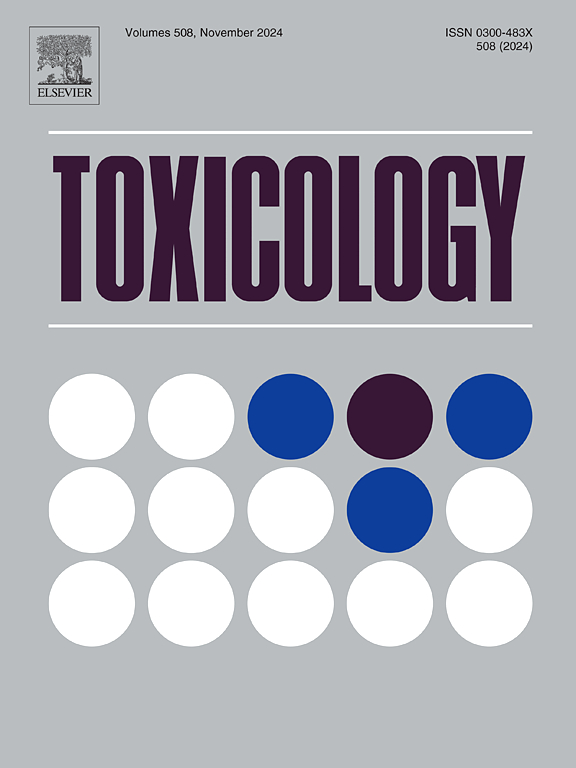Embryonic exposure to GenX causes reproductive toxicity by disrupting the formation of the blood-testis barrier in mouse offspring
IF 4.8
3区 医学
Q1 PHARMACOLOGY & PHARMACY
引用次数: 0
Abstract
As a replacement for perfluorooctanoic acid, hexafluoropropylene oxide dimer acid, commercially referred to as “GenX”, has attracted significant attention. However, a comprehensive understanding of the reproductive systems of male offspring exposed to GenX is lacking. This study aimed to investigate how embryonic exposure to GenX affects the reproductive development of male offspring and the underlying mechanisms. We administered GenX daily via gavage (2 mg/kg body weight/day) to the mice from day 12.5 of pregnancy until delivery. Our results suggested that embryonic exposure to GenX led to delayed onset of puberty in male offspring, with destruction of the testicular structure, disruption of the blood-testis barrier, decreased serum testosterone levels, decreased sperm count, impaired sperm motility, and increased rates of sperm abnormalities. We investigated the mechanism of blood-testis barrier breakdown in vitro by treating Sertoli cells (TM4) with GenX. GenX exposure caused the accumulation of senescent TM4 cells, decreased their glutathione (GSH) levels, and increased their oxidized glutathione levels. GenX inhibited glutaminase activity in TM4 cells, leading to decreased GSH synthesis, increased intracellular oxidative stress, and subsequent TM4 cell senescence, ultimately compromising the blood-testis barrier. Our findings indicated that embryonic exposure to GenX may cause Sertoli cell senescence by altering glutamine metabolism, disrupting the blood-testis barrier, and resulting in abnormal reproductive development in male offspring.
胚胎暴露于GenX通过破坏小鼠后代血睾丸屏障的形成而引起生殖毒性
作为全氟辛酸的替代品,商业上称为“ GenX ”的六氟环氧丙烷二聚酸引起了极大的关注。然而,对暴露于GenX的雄性后代的生殖系统缺乏全面的了解。本研究旨在探讨胚胎暴露于GenX如何影响雄性后代的生殖发育及其潜在机制。从妊娠第12.5天至分娩,每天给小鼠灌胃GenX(2 mg/kg体重/天)。我们的研究结果表明,胚胎暴露于GenX导致男性后代青春期延迟,睾丸结构破坏,血睾丸屏障破坏,血清睾酮水平降低,精子数量减少,精子活力受损,精子异常率增加。我们用GenX治疗支持细胞(TM4),研究了血睾丸屏障在体外破坏的机制。GenX暴露引起衰老TM4细胞的积累,降低其谷胱甘肽(GSH)水平,并增加其氧化谷胱甘肽水平。GenX抑制TM4细胞中的谷氨酰胺酶活性,导致GSH合成减少,细胞内氧化应激增加,随后TM4细胞衰老,最终损害血睾丸屏障。我们的研究结果表明,胚胎暴露于GenX可能通过改变谷氨酰胺代谢,破坏血睾丸屏障,导致雄性后代生殖发育异常而导致支持细胞衰老。
本文章由计算机程序翻译,如有差异,请以英文原文为准。
求助全文
约1分钟内获得全文
求助全文
来源期刊

Toxicology
医学-毒理学
CiteScore
7.80
自引率
4.40%
发文量
222
审稿时长
23 days
期刊介绍:
Toxicology is an international, peer-reviewed journal that publishes only the highest quality original scientific research and critical reviews describing hypothesis-based investigations into mechanisms of toxicity associated with exposures to xenobiotic chemicals, particularly as it relates to human health. In this respect "mechanisms" is defined on both the macro (e.g. physiological, biological, kinetic, species, sex, etc.) and molecular (genomic, transcriptomic, metabolic, etc.) scale. Emphasis is placed on findings that identify novel hazards and that can be extrapolated to exposures and mechanisms that are relevant to estimating human risk. Toxicology also publishes brief communications, personal commentaries and opinion articles, as well as concise expert reviews on contemporary topics. All research and review articles published in Toxicology are subject to rigorous peer review. Authors are asked to contact the Editor-in-Chief prior to submitting review articles or commentaries for consideration for publication in Toxicology.
 求助内容:
求助内容: 应助结果提醒方式:
应助结果提醒方式:


